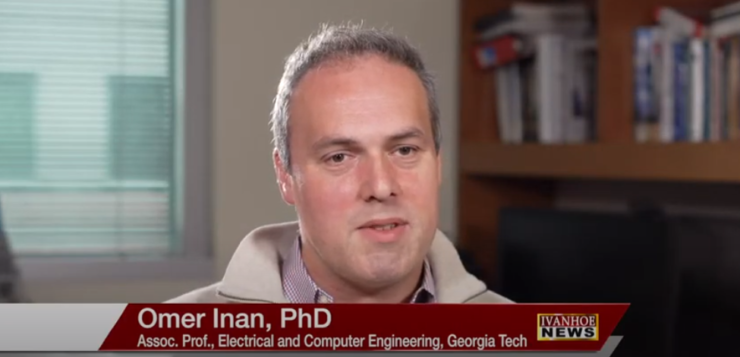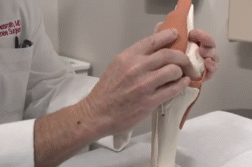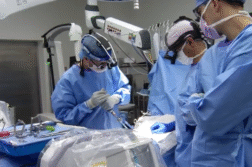Omer Inan, Associate Professor of Electrical and Computer Engineering at Georgia Tech, talks about how acoustics can measure what’s happening to your joints.
How did the idea of using sound interpretation come about?
Professor Inan: I was a discus thrower at Stanford, and I had to do quite a bit of heavy lifting, power cleans, Olympic lifts and squats. Over the years of putting my knees and ankles under a lot of stress I started to notice that I would have these sounds and kind of creaking effects coming from my knees when I would do basic exercises. When I started at Georgia Tech, I had this background of knowing about professional audio. I was a Chief Engineer for a professional audio company in the Bay Area. We built small lapel microphones and on-body microphones for theatres, broadcasts and other sorts of industries. So, I knew that you could put small microphones on the body. At the same time, I also knew that the joints can creak and make some sounds and maybe you can have some interesting value from a scientific standpoint. So I had this idea to take an ordinary knee brace and put some microphones in there to try to listen to some of the sounds coming out of the joint when the person moves and then try to relate those sounds to something that is of value from a health standpoint.
What exactly was the need that you were trying to address designing this brace?
Professor Inan: In cardiovascular medicine, there are many tools that you can use to quantify the state of somebody’s cardiovascular health. We use stethoscopes, electrocardiogram measurements, echo – there’s just a whole set of tools available for physicians to understand in a quantifiable way the health of the heart and the vasculature. But when you think about the knees and joints in the body and the tools that we have available for quantifying their health, especially outside of clinical settings, pretty much all you have is a measurement of the angles from the joints and their movement patterns. But if you want to understand at a more deep level the inside of the joint and find out how the structures are doing, the health of the ligaments, if a person has arthritis, if they have inflammation, how the joint is actually being affected from a health standpoint internally? There’s very little available in terms of tools. I thought that acoustics would be a nice way for us to sit on the outside of the body and still be able to measure what’s going on inside with a lot more depth of information than what you can get with current methods.
You talked about the microphone. Describe exactly how this device works?
Professor Inan: We call them microphones, but we measure the sounds from inside of the body with accelerometers. The reason is that the body is filled with fluid and the outside of the body you have air. If you put a microphone next to the joint, there’s very little sound that’s penetrating outside of the skin and getting outside into the air. What happens is most of the sounds are reflected off the skin. And when they’re reflected off the skin, they produce small vibrations of the skin that can be sensed by acceleration sensors or accelerometers that we put right on the skin of the person. It’s a similar concept to a throat mic, which is something that a helicopter pilot or someone else in a loud environment might use where they put a sensor directly on the throat. Rather than measuring the sound production and what comes out of the air, they measure the vibrations of the throat. And they transduce the sound in that way. So, we do the same kind of thing on the skin. It’s also what a stethoscope does. When you put a stethoscope on the chest, the head of the stethoscope takes the vibrations of the skin and translates them into acoustic energy that then goes into your ears. In our case, we’re taking these vibrations of the skin and instead of translating them to acoustic energy that goes to the ears, we’re translating them to electrical energy that we can then measure with our device.
What’s the difference in the sound of a knee when its injured?
Professor Inan: What we found is that an injured knee has more variability in their sounds. With a healthy knee in each of its movement patterns where those movements themselves are consistent, let’s say the person just extends and then flexes their leg, what we’ve found is that those sounds are consistent for that person. If you flexed or extended your knee repeatedly, you would get a very similar kind of content of sound produced by that. If someone has an injury, we found that those sounds are more variable. So the person performs the same movement, but maybe because of the fact that their ACL is torn, maybe because of the fact that there’s a torn meniscus or some other underlying defect in the structure, the sounds that are produced are a little bit more variable in their nature. So, there might be more erratic sounds produced. The frequencies of those sounds might be different from cycle to cycle and there might be more what we call entropy in those sounds.
Can you talk a little bit about this study?
Professor Inan: When we first started on this work, we were really interested in how this might be beneficial to athletes. The first person we worked with was a student athlete at Georgia Tech. We paired up with the athletic department and athletic trainers and recruited student athletes with healthy knees and some with acute knee injuries. We ended up recruiting about 45 people total. We noticed that the athletes that had a prior injury within the past week to their knee produced very different sounds in nature than the athletes who were age matched, gender matched, size matched to those athletes. We thought that there would be something interesting there. So, we started looking into it more deeply. We also recorded the same athletes six months after surgery and after six months of rehab. We noticed that their sound started to look more like the healthy population but weren’t quite there yet.
How long does it normally take for the sounds to get back to healthier knee sound?
Professor Inan: For the athletes that we had, we only had two measurements. One immediately after the injury and then one six months later. So, it’s harder for us to tell if, for example, after one month did they start getting closer to how they started. We have a current study now where we’re looking specifically at a patient’s post-meniscus tear and we’re going to be recording from those patients much more frequently. That study is going to be done at Northwestern University where our very close collaborators are on this project.
Who do you believe this would benefit most?
Professor Inan: It’s hard to say who would benefit the most from this technology because everyone has knees and everyone at some point may have problems. But I would say a population that really could benefit from this in the short term is kids with arthritis. There’s specifically a condition called juvenile idiopathic arthritis. There are about 50,000 kids in the U.S. that have JIA. It’s a very heterogenous disorder. It’s a disability. It really affects a person’s quality of life and there are very few markers that can be used for evaluating the level of inflammation, the level of arthritis and involvement in a person over time. So we paired up with Children’s Health Care of Atlanta and specifically with Dr. Prahalad who’s the pediatric rheumatology chief there to be able to study joint sounds in kids with JIA to see if that could be a biomarker that could ultimately be used not only to diagnose JIA in nonspecialized sort of settings but also to be able to track the progress of JIA over time and to see if treatments are working properly. I think that in the shortest term that would be a very powerful, important and impactful opportunity for this project to be successful.
Since you guys are also testing this with kids, is there a difference between younger knees versus older knees in sound?
Professor Inan: What we found is that in healthy kids without arthritis, without knee pain or injuries there are almost no sounds produced by the knee. At least they’re quiet enough where our device can’t even pick them up versus if you take healthy students at Georgia Tech or healthy people in the age range of 18 to 30 or older almost all these produce sounds. My knees would produce loud sounds, even though I don’t have necessarily a knee injury right now. And your knees would produce sounds. But a kid who’s 8 years old who doesn’t have arthritis, their knees are very well lubricated, the cartilage is still very much intact and because of that the joint articulation is very nice and controlled and repeatable. So because of that their knee doesn’t really produce much sound. That’s very interesting. So, when you have kids with arthritis, you notice almost immediately that there’s a striking difference in the sounds. For kids with arthritis, you do start seeing sounds produced by the knees. And they have signatures that would indicate that the joint age may be older in some ways than the age of the person.
Are there any other studies coming out of this?
Professor Inan: We’re measuring joint sounds in a variety of scenarios. We have one case where the kids with arthritis study here, another case we’re studying joint sounds in the context of acute knee injuries. That’s both here at Emory and at Northwestern. We’re also interested in how joint sounds are affected by rheumatoid arthritis in adults. We have a study that’s just starting at the University of Minnesota as well.
You guys are all over the place studying this?
Professor Inan: We are because we think this is a new vital sign for knee health. So, we want to examine as many applications as we can. In fact, we also want to understand it at a more basic level. We’ve even done studies in cadaver limbs where the mechanical aspects of the tissue are still intact but where we can do things such as perform a surgery to create a meniscus tear and see how that affects the sounds before and after. We think if these sounds are better understood that we would have for the first time a quantifiable, wearable metric of the underlying physiology and structure of the knee. And that would be very important for multiple clinical applications.
How far down the line do you see this going? I guess, wide scale, every orthopedic office should have this kind of device?
Professor Inan: We have this very multi-disciplinary and complex problem where we must better understand at a scientific level why these sounds occur and what types of changes to the joints affect these sounds. On one hand, it’s an engineering problem where we want to say how do we measure these things accurately in a device that’s a brace that a person could take home. How do we store the data without using so much power that the person has to charge the battery every couple of hours? And then the clinical questions and challenges for a specific arthritis like how the sounds might change. Is it specific enough to that arthritis compared to other knee pain where you could really make a meaningful conclusion from the sounds that you’re listening to? Because it’s such a multiheaded, kind of multidisciplinary problem, I think the road to getting commercialized and into clinics is still a bit longer. But I do think that compared to something like an implantable device or compared to a new pharmaceutical new drug, once we have some of these questions addressed the road to commercialization should be a lot smoother because the types of studies required are less invasive. We can hopefully get a lot of patients to sign up and try this out. And then I think the ultimate device manufacturing and distribution might be less challenging as well.
How do you believe this can impact someone’s quality of life whether they’re professional, a school athlete, their kid has arthritis or they’re an older person dealing with arthritis?
Professor Inan: I think we live in a world now where we expect to have data in front of us. We want to know all the time what’s the level of fuel remaining in my car, what’s my thermostat set at and why and what it should be set at. We want to control things with Wi-Fi and with smartphones. We want to be able to understand what’s going on with our life and to have more empowerment and control over it. Unfortunately if you have a knee injury, if you’re a soccer player in high school with a knee injury or if you’re a kid who’s 8 years old with juvenile arthritis, you’ve been diagnosed and your parents know that so you leave the clinical setting where the diagnosis occurs and you have almost no data about how things are doing. You have no way of telling what happens if I start doing hurdle hops again or what happens if I start cutting in soccer and how will that impact my knee. You’re always living with that fear and lack of knowledge. So, I think that by having these devices out there, we can empower patients, their families and their caregivers to have better data on a long-term basis about how their knees are doing and then they could make better informed decisions themselves and the clinical decisions regarding their care could also be more informed by the current state of the person and the current state of the knee.
Interview conducted by Ivanhoe Broadcast News.
END OF INTERVIEW
This information is intended for additional research purposes only. It is not to be used as a prescription or advice from Ivanhoe Broadcast News, Inc. or any medical professional interviewed. Ivanhoe Broadcast News, Inc. assumes no responsibility for the depth or accuracy of physician statements. Procedures or medicines apply to different people and medical factors; always consult your physician on medical matters.
If you would like more information, please contact:
Ben Brumfield, Media Relations
Georgia Tech
Sign up for a free weekly e-mail on Medical Breakthroughs called First to Know by clicking here




